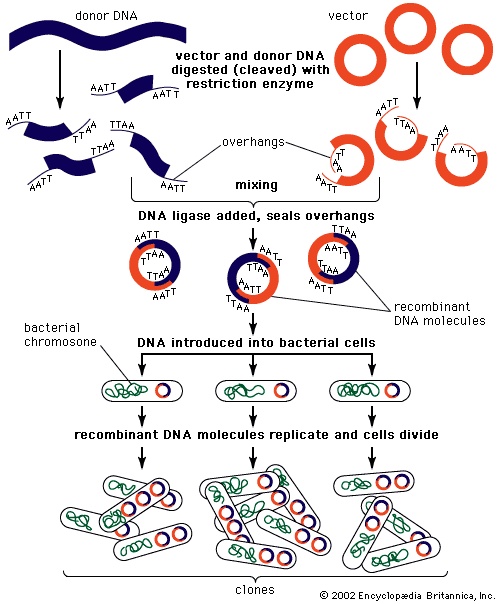genetic engineering
the artificial manipulation, modification, and recombination of DNA or other nucleic acid molecules in order to modify an organism or population of organisms.
 The term genetic engineering initially meant any of a wide range of techniques for the modification or manipulation of organisms through the processes of heredity and reproduction. As such, the term embraced both artificial selection and all the interventions of biomedical techniques, among them artificial insemination, in vitro fertilization (e.g., “test-tube” babies), sperm banks, cloning, and gene manipulation. But the term now denotes the narrower field of recombinant DNA technology, or gene cloning (recombination) (see Figure-->
The term genetic engineering initially meant any of a wide range of techniques for the modification or manipulation of organisms through the processes of heredity and reproduction. As such, the term embraced both artificial selection and all the interventions of biomedical techniques, among them artificial insemination, in vitro fertilization (e.g., “test-tube” babies), sperm banks, cloning, and gene manipulation. But the term now denotes the narrower field of recombinant DNA technology, or gene cloning (recombination) (see Figure--> ), in which DNA molecules from two or more sources are combined either within cells or in vitro and are then inserted into host organisms in which they are able to propagate. Gene cloning is used to produce new genetic combinations that are of value to science, medicine, agriculture, or industry.
), in which DNA molecules from two or more sources are combined either within cells or in vitro and are then inserted into host organisms in which they are able to propagate. Gene cloning is used to produce new genetic combinations that are of value to science, medicine, agriculture, or industry.DNA is the carrier of genetic information; it achieves its effects by directing the synthesis of proteins. Most recombinant DNA technology involves the insertion of foreign genes into the plasmids of common laboratory strains of bacteria. Plasmids (plasmid) are small rings of DNA; they are not part of the bacterium's chromosome (the main repository of the organism's genetic information). Nonetheless, they are capable of directing protein synthesis, and, like chromosomal DNA, they are reproduced and passed on to the bacterium's progeny. Thus, by incorporating foreign DNA (for example, a mammalian gene) into a bacterium, researchers can obtain an almost limitless number of copies of the inserted gene. Furthermore, if the inserted gene is operative (i.e., if it directs protein synthesis), the modified bacterium will produce the protein specified by the foreign DNA.
A key step in the development of genetic engineering was the discovery of restriction enzymes (restriction enzyme) in 1968 by the Swiss microbiologist Werner Arber (Arber, Werner). However, type II restriction enzymes, which are essential to genetic engineering for their ability to cleave a specific site within the DNA (as opposed to type I restriction enzymes, which cleave DNA at random sites), were not identified until 1969, when the American molecular biologist Hamilton O. Smith (Smith, Hamilton Othanel) purified this enzyme. Drawing on Smith's work, the American molecular biologist Daniel Nathans (Nathans, Daniel) helped advance the technique of DNA recombination in 1970–71 and demonstrated that type II enzymes could be useful in genetic studies. Genetic engineering itself was pioneered in 1973 by the American biochemists Stanley N. Cohen and Herbert W. Boyer, who were among the first to cut DNA into fragments, rejoin different fragments, and insert the new genes into E. coli bacteria, which then reproduced.
Genetic engineering has advanced the understanding of many theoretical and practical aspects of gene function and organization. Through recombinant DNA techniques, bacteria have been created that are capable of synthesizing human insulin, human growth hormone, alpha interferon, a hepatitis B vaccine, and other medically useful substances. Plants may be genetically adjusted to enable them to fix nitrogen, and genetic diseases can possibly be corrected by replacing “bad” genes with “normal” ones. Nevertheless, special concern has been focused on such achievements for fear that they might result in the introduction of unfavourable and possibly dangerous traits into microorganisms that were previously free of them—e.g., resistance to antibiotics, production of toxins, or a tendency to cause disease.
The “new” microorganisms created by recombinant DNA research were deemed patentable in 1980, and in 1986 the U.S. Department of Agriculture approved the sale of the first living genetically altered organism—a virus, used as a pseudorabies vaccine, from which a single gene had been cut. Since then several hundred patents have been awarded for genetically altered bacteria and plants.
- Hanna Reitsch
- Hanna Suchocka
- Hannes Alfvén
- Hannes Hafstein
- Hannes Kolehmainen
- Hannes Schneider
- Hannibal
- Hannibal Hamlin
- Hannibal Sehested
- Hannington, James
- Hanni Wenzel
- Hanno
- Hannover
- Hanoi
- Hanotaux, Gabriel
- Hanover
- Hanover, House of
- Hanriot, François
- Han River
- Hans Adam II, prince of Liechtenstein
- Hans Adolf Brorson
- Hans Adolf Eduard Driesch
- Hans Aeschbacher
- Hans Axel von Fersen
- Hans Baldung-Grien